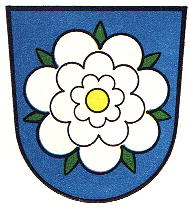Bramsche: Difference between revisions
Jump to navigation
Jump to search
Knorrepoes (talk | contribs) No edit summary |
Knorrepoes (talk | contribs) |
||
| Line 18: | Line 18: | ||
The arms were officially granted in 1941, but the rose as a symbol is known from the oldest seal, dating from 1709. The origin of the rose is not known. It has been speculated that it is the symbol for the guild of weavers and textile workers in the town. | The arms were officially granted in 1941, but the rose as a symbol is known from the oldest seal, dating from 1709. The origin of the rose is not known. It has been speculated that it is the symbol for the guild of weavers and textile workers in the town. | ||
[[Literature]] : Stadler, K. : Deutsche Wappen - Bundesrepublik Deutschland. Angelsachsen Verlag, 1964-1971, 8 volumes. | [[Literature]] : Stadler, K. : Deutsche Wappen - Bundesrepublik Deutschland. Angelsachsen Verlag, 1964-1971, 8 volumes. | ||
Revision as of 12:10, 8 March 2014
| Heraldry of the World Civic heraldry of Germany - Deutsche Wappen (Gemeindewappen/Kreiswappen) |
BRAMSCHE
State : Niedersachsen<br.
District (Kreis) : Osnabrück (until 1972Bersenbrück)
Additions : 1971 Achmer; 1972 Balkum, Engter, Epe, Evinghausen, Hesepe, Kalkriese, Pente, Schleptrup, Sögeln, Ueffeln
Official blazon
Origin/meaning
The arms were officially granted in 1941, but the rose as a symbol is known from the oldest seal, dating from 1709. The origin of the rose is not known. It has been speculated that it is the symbol for the guild of weavers and textile workers in the town.
Literature : Stadler, K. : Deutsche Wappen - Bundesrepublik Deutschland. Angelsachsen Verlag, 1964-1971, 8 volumes.

